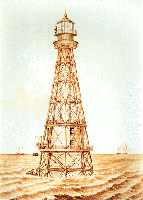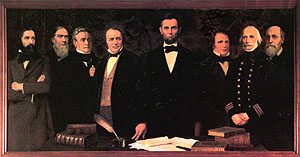JOSEPH HENRYScience AdviserBy Marc RothenbergEditor, Joseph Henry Papers Project When Joseph Henry accepted the position as Secretary of the Smithsonian on December 7, 1846, he was the foremost experimental physicist in the United States. The responsibilities of his new post, however, would require a great personal sacrifice. Never again would Henry have enough time to pursue his own research agenda. Although Henry never ceased thinking of himself as a research scientist and educator, after becoming Secretary his chief roles were those of science administrator and adviser to presidents, vice presidents, cabinet secretaries, and members of Congress on all aspects of science and technology. When Henry entered the laboratory, he no longer pursued basic research or followed up a random observation that struck his curiosity. As a member of various government boards and commissions, Henry now devoted himself to applied research. As an adviser, Henry had tremendous influence. His correspondence demonstrates that the careers of individual scientists, the livelihoods of inventors, and the future of certain government scientific activities came to depend in part upon his support and his ability to sway members of Congress or cabinet members. Such was his reputation that, according to Henry, one secretary of the interior assured him that "if the request was . . . backed by myself that would be sufficient!" The nation came to depend on his expertise in a number of areas. For the United States Capitol Building, for example, he was called upon by the vice-president and various cabinet secretaries to provide advice on the vulnerability of the Capitol dome to lightning; to evaluate the plans of Montgomery C. Meigs for the acoustics, heating, and ventilation of the new chamber of the House of Representatives; and to test samples of marble for the Capitol extension.
Henry devoted even more time to the country's system of lighthouses. In 1852, he was appointed by President Millard Fillmore as one of the six members of the United States Light-House Board. Henry remained on the board for the next twenty-five years, serving as chairman for the last six years of his life. Thus, he had a role in the oversight of a government science-technology activity with an annual budget of more than $500,000 in 1852, or sixteen times the Smithsonian annual budget at the time. The United States Light-House Board was responsible for the construction and repair of lighthouses; the establishment of procedures; and the procurement of personnel, supplies, and equipment. Henry took charge of its experimental and testing activities. After his death it was estimated that, in addition to attending board meetings, he generally spent from six to eight weeks each year working full-time for the board during his vacations from the Smithsonian. He helped make the board into a center for applied research in optics, thermodynamics, and acoustics. Henry served the nation in another capacity during the Civil War. Inventors overwhelmed the government with suggestions for various kinds of military technology at a time when there was no mechanism for screening and evaluating the proposals. Henry, to whom the military referred many of these, suggested the establishment of what became known as the Permanent Commission of the Navy Department. Henry served on the three-member commission from its inception in early 1863, and the group met as often as three times a week, often in the Castle, to evaluate a steady stream of proposals for warship designs, underwater guns, torpedoes, and the like. Henry wrote former President Fillmore after the war that the commission saved the government "from rushing into many schemes which, under the guise of patriotism, were intended to advance individual interest." The National Academy of Sciences was also established in the spring of 1863 to offer scientific advice to the government. Henry was one of its fifty incorporators. When his dear friend and first president of the academy, Alexander Dallas Bache, died in 1867, Henry, who had been acting president of the academy during Bache's illness, agreed to serve as president. Until his death in 1878, he was concurrently Secretary of the Smithsonian Institution and president of the National Academy of Sciences, as was Charles Doolittle Walcott, the Smithsonian's fourth Secretary, some fifty years later. Henry's years of service as science adviser, as much as his own pioneering research, make fitting the headline in the New York Times upon his death, "A Loss to All the Nation." At Henry's memorial service, held in the Capitol on January 16, 1879, congressional Regent (and later President of the United States) James A. Garfield acknowledged that Henry's move to Washington, D.C., was a loss to research. But he reminded his audience that "the Republic has the right to call on all her children for service. It was needful that the Government should have, here at its capital, a great, luminous-minded, pure-hearted man, to serve as its counselor and friend in matters of science." Public Servant || Educator || Promoter of Anthropology || Scientist & Christian || Readings Henry Home || IHD Home || Smithsonian Institution Archives Home |

